 May 08, 2025
Persona
May 08, 2025
Persona
Table of Contents
- What Is Content Marketing?
- Why Content Marketing Matters for Higher Ed
- Best Practice #1: Understand Your Evolving Audience
- Best Practice #2: Tap into Storytelling as a Competitive Advantage
- Best Practice #3: Maintain an Engaging and Timely Blog
- Best Practice #4: Embrace Video-Forward and Short-Form Content
- Best Practice #5: Optimize for Search and Social Discovery
- Best Practice #6: Personalize Your Content Through Segmentation
- Best Practice #7: Activate Email Campaigns as a Nurturing Tool
- Best Practice #8: Prioritize Data Analysis to Refine Strategies
- Best Practice #9: Explore Emerging Technologies and Trends
- Best Practice #10: Foster Community Through User-Generated Content (UGC)
- Building a Future-Ready Content Strategy
Higher education is at a crossroads where meeting the expectations of digital-savvy audiences can make or break enrollment goals.
Standing out today requires more than sporadic campus updates on social media or the occasional success story. It’s about crafting a cohesive and compelling narrative. One that connects deeply with prospective students, parents, faculty, and alumni alike.
While content marketing has been a staple strategy for many institutions, 2025 brings a sharper focus on authenticity, personalized engagement, and the power of data-driven insights to drive meaningful connections.
What Is Content Marketing?
Content marketing is a strategic approach to communication and engagement that focuses on delivering high-quality, relevant, and consistent content. This includes (but isn’t limited to) articles, videos, social media posts, and other formats designed to attract, engage, and retain a clearly defined audience.
Unlike traditional marketing, content marketing isn’t about overtly promoting your institution. It’s about building trust, establishing authority, and enhancing brand awareness over time.
The ultimate goal? Inspire meaningful actions from your audience, whether it’s applying, enrolling, or deepening their connection with your institution.
WANT TO LEARN ABOUT OUR CONTENT MARKETING OFFERING? GET IN TOUCH.
Why Content Marketing Matters for Higher Ed

When a prospective student or donor is scrolling online, what makes them pause on your institution? Authentic content that shows what makes your school special in a way that feels real and relatable.
Content marketing lets you showcase your unique value, build trust, and foster meaningful connections with key audiences—students, parents, faculty, and alumni.
You can strengthen your college or university’s brand identity by consistently producing engaging and relevant content, such as blog posts, videos, and social media updates.
This approach also allows you to highlight what truly sets your institution apart, from academic excellence to campus culture. Effective content marketing ensures you stand out in an era when prospective students rely heavily on online research during their college search.
Through faculty research, expert interviews, and thought-provoking articles, you can build your school’s credibility as a thought leader in its field.
Content marketing also keeps current students, alumni, and donors engaged, fueling community pride and a deeper sense of belonging. The payoff is enrollment growth, fundraising success, and a community that feels connected to your institution.
By delivering stories and insights that resonate with your audience, you give them the confidence and connection needed to take the next step.
Below, we’ve combined 10 timeless best practices with actionable insights to help your institution stay ahead of the curve. Let’s dive in.
Best Practice #1: Understand Your Evolving Audience
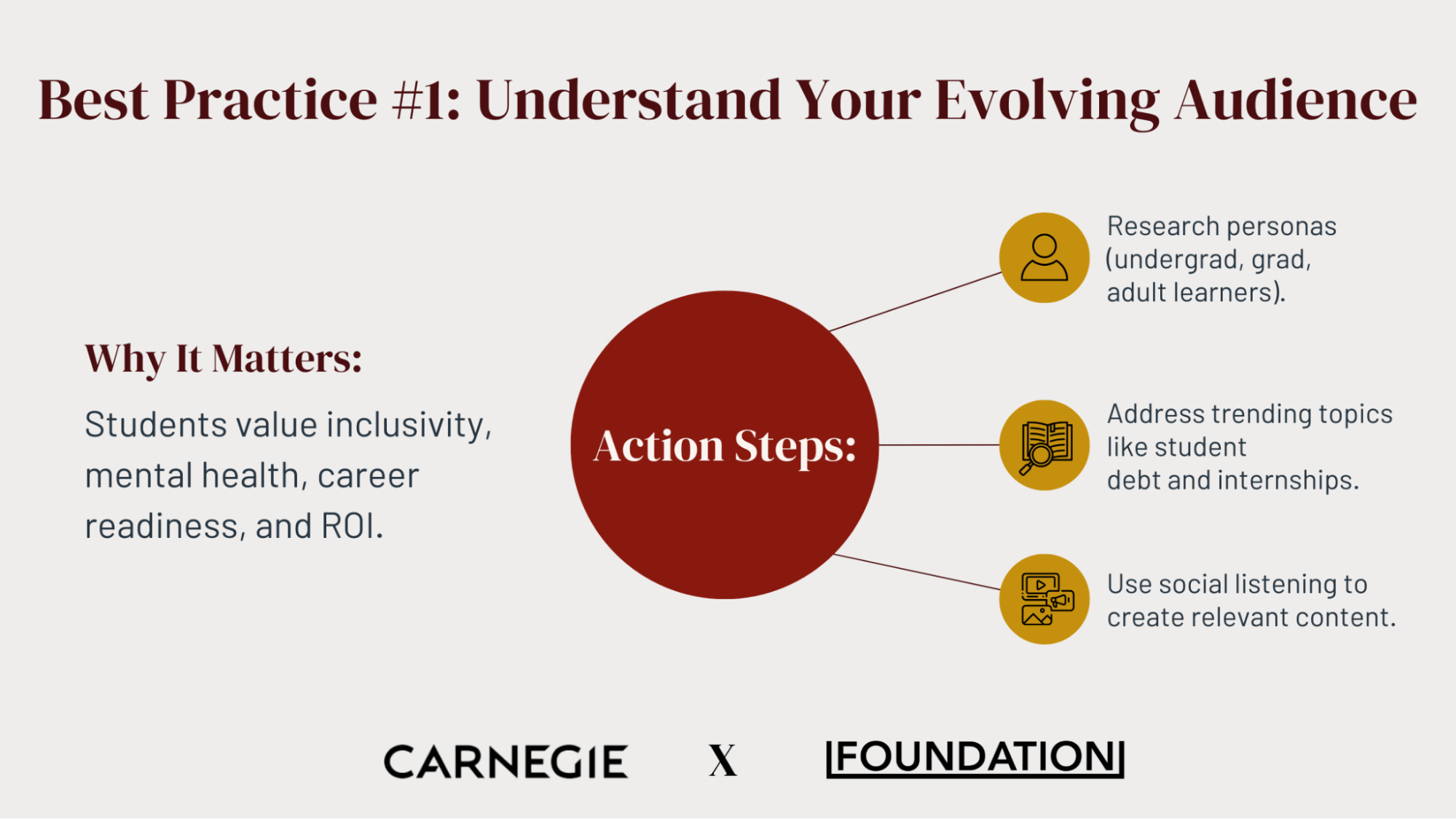
Why It Matters
College-bound students, especially Gen Z and the emerging Gen Alpha, have more information at their fingertips than ever. They’re searching for schools that not only provide quality academics but also prioritize inclusivity, mental health, career readiness, and vibrant campus life.
Meanwhile, adult learners returning to college or graduate programs seek flexible, career-focused content that proves the ROI of advanced education.
For many schools, the question becomes: How do we capitalize on the search habits of today’s students? The answer is simple but requires commitment—conduct content marketing research and use your insights to create content that aligns with what your audience is actively looking for.
That might be answers to questions about balancing work and study, tips on choosing a major, or details about internship programs.
This strategy isn’t guesswork; it’s rooted in data. Research from Modern Campus shows 58% of students use search engines to find college or university websites, followed by social media.
If you invest in content that ranks well in search results, you can reach prospective students at the moment they’re searching for solutions or inspiration.
Think of each piece of content as an investment: The more comprehensive and targeted the content, the better it will perform over time—driving traffic, applications, and brand awareness without repeated advertising costs.
Action Steps
- Conduct Persona Research: Develop distinct personas for undergraduate, graduate, international, and adult learners. Gather demographic and psychographic details—like academic interests, career goals, and lifestyle preferences—and build content accordingly.
- Track Emerging Topics: Stay informed on trending student concerns, from student debt and housing to internship and networking opportunities. Tackle these topics in your blog posts, videos, and social media content.
- Leverage Social Listening: Monitor social media platforms, student forums, and online groups to gauge student sentiment. Pinpoint their most pressing questions, and use your content to provide transparent, relevant answers.
Best Practice #2: Tap into Storytelling as a Competitive Advantage
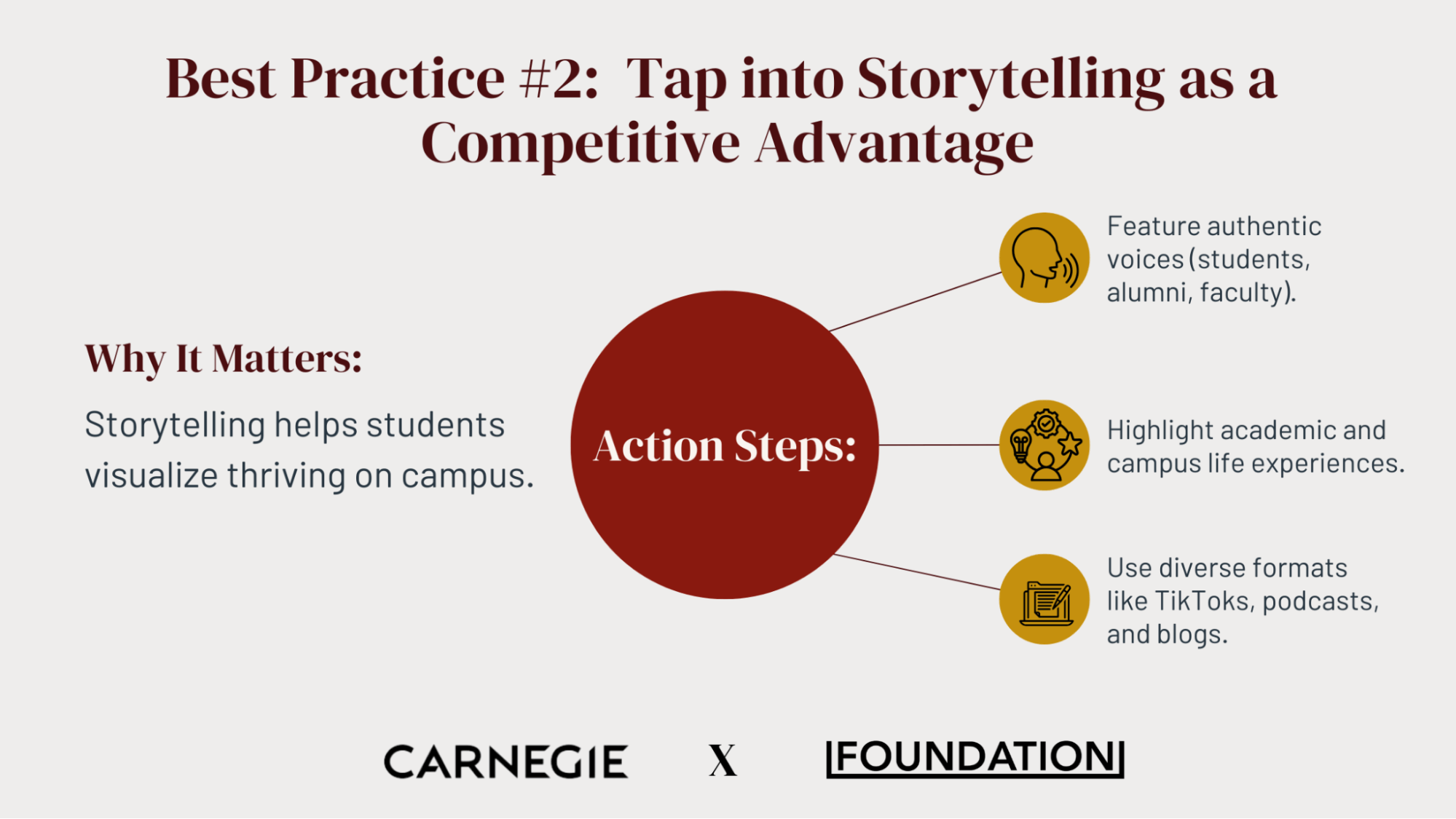
Storytelling allows prospective students to see themselves thriving on campus. Students crave content featuring real people—peers, mentors, and faculty—with whom they can identify or aspire to emulate.
Action Steps
- Feature Authentic Voices: Showcase student ambassadors, alumni, and faculty across different departments. Ask them to share day-in-the-life experiences, success stories, and personal challenges to give prospective students a true sense of your institution’s community.
- Elevate Academic Experiences: Go beyond the fun side of campus life and spotlight academic storytelling. Highlight research breakthroughs, interdisciplinary projects, and real-world applications of classroom theory.
- Diversify Formats: Weave storytelling into everything from podcast interviews to short-form TikTok videos. For each piece of content, decide which format (written, video, podcast) best conveys the narrative you want to share.
Best Practice #3: Maintain an Engaging and Timely Blog
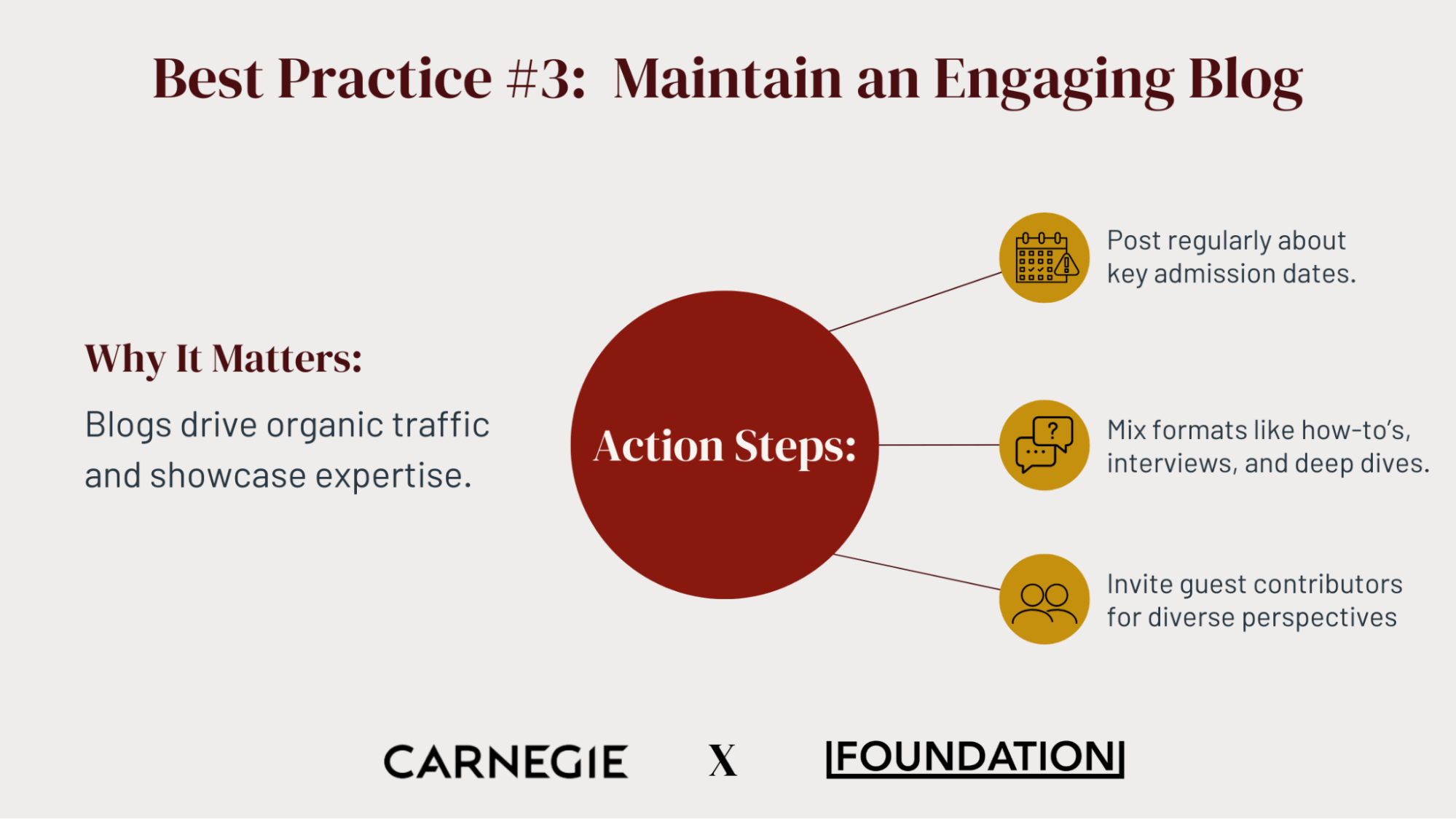
Why It Matters
A blog remains one of the most consistent platforms for driving organic traffic and showcasing your expertise. It’s also an excellent channel for addressing frequently asked questions, highlighting new campus initiatives, or sharing industry insights.
Some of the most successful higher ed institutions have discovered how to harness content to drive staggering volumes of organic traffic.
One example is Boston University, an institution generating over 800,000 monthly visits just from people finding their content in organic search results.
Here’s a snapshot of their organic traffic and the value of that traffic based on Ahrefs data:
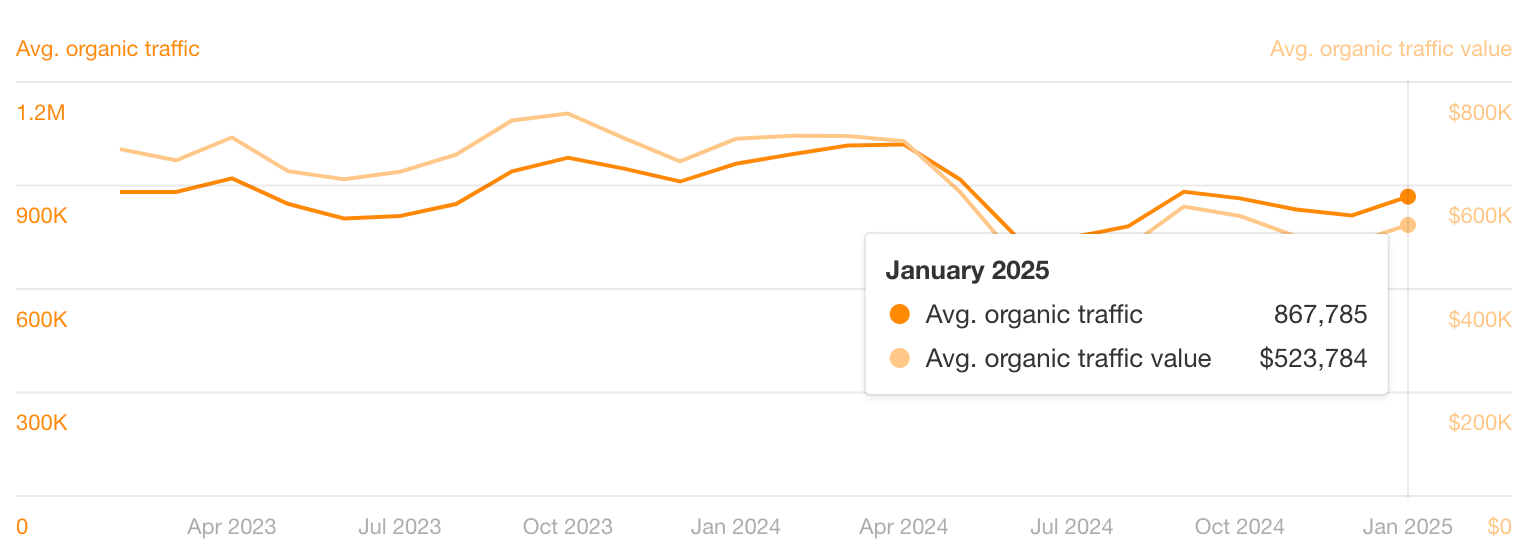
Institutions like this reap the benefits of evergreen content: Publish once, and the ROI can keep rolling in for years.
Organic traffic saves on budget, too. If your institution can rank for high-value keywords in search results, you don’t have to pay for clicks.
More importantly, appearing in both paid and organic search results—“double-dipping”—increases your credibility and captures more attention from prospective students. After all, if your school appears twice on the search page, you’re more likely to garner that crucial click.
Action Steps
- Map Out a Content Calendar: Schedule regular posts around key admissions dates, campus events, holidays, or enrollment deadlines.
- Experiment with Different Formats: Intersperse listicles, how-to guides, interview pieces, academic deep-dives, and student/alumni profiles to keep content fresh.
- Encourage Guest Contributions: Invite respected faculty, community partners, or alumni to write or co-author articles. This not only diversifies the blog’s content but also demonstrates thought leadership.
Best Practice #4: Embrace Video-Forward and Short-Form Content
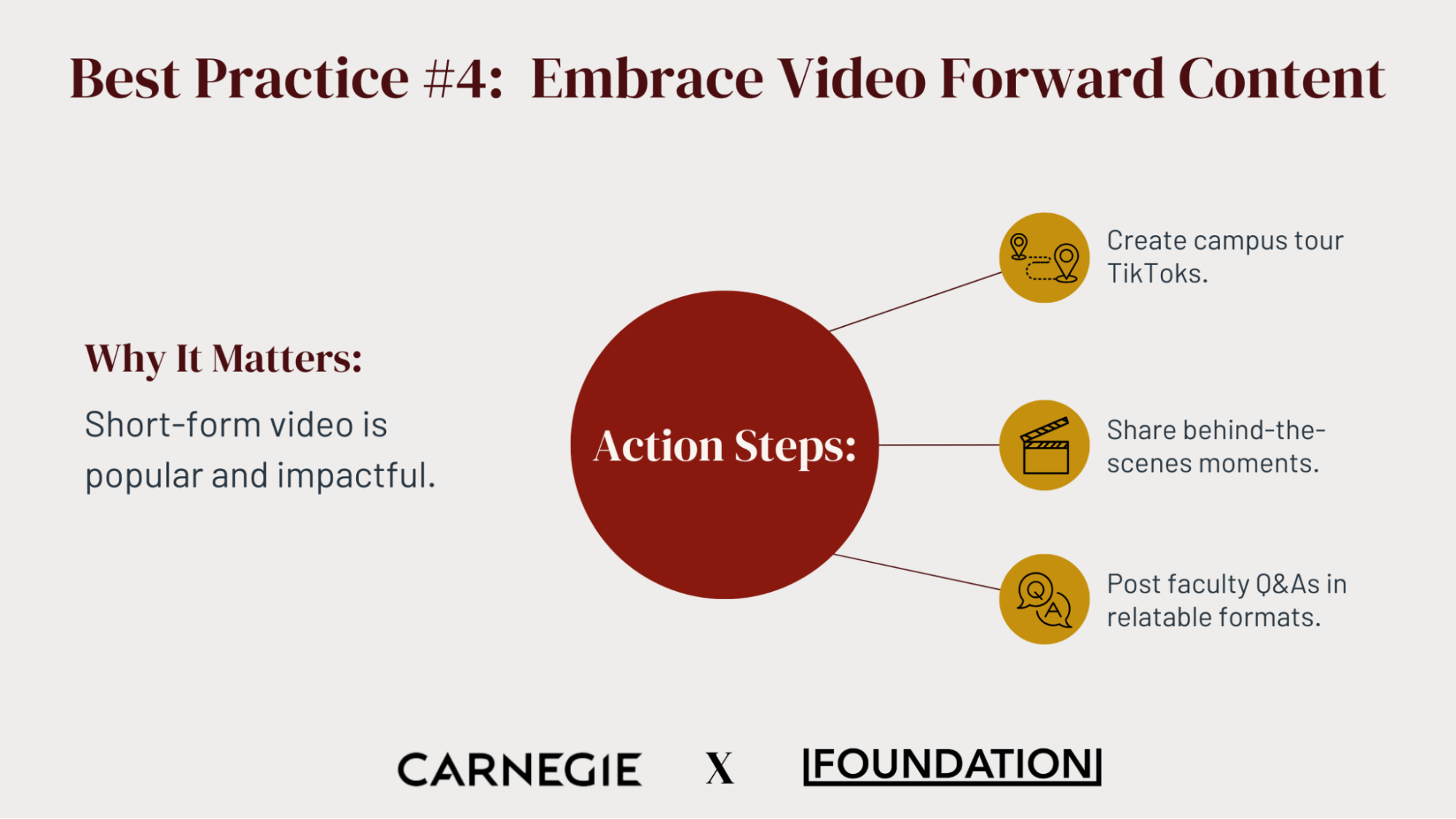
H4: Why It Matters
With platforms like TikTok, Instagram Reels, and YouTube Shorts surging in popularity, prospective students gravitate toward snackable, captivating video content. Short-form video offers an immediate, dynamic way to showcase your campus culture, highlight events, and shine a light on academic rigor—all in under a minute.
Action Steps
- Create Campus Tour TikToks: Provide fun, quick tours of key facilities—residence halls, dining areas, labs, and athletic centers—to help students visualize life on campus.
- Post Behind-the-Scenes Reels: Let prospective students peek behind the curtain by filming snippets of orientation activities, lab work, internship programs, or study-abroad journeys.
- Spotlight Faculty Activities: Showcase short Q&A videos featuring professors sharing snippets of their research or explaining complex topics in a simple, relatable way.
Best Practice #5: Optimize for Search and Social Discovery
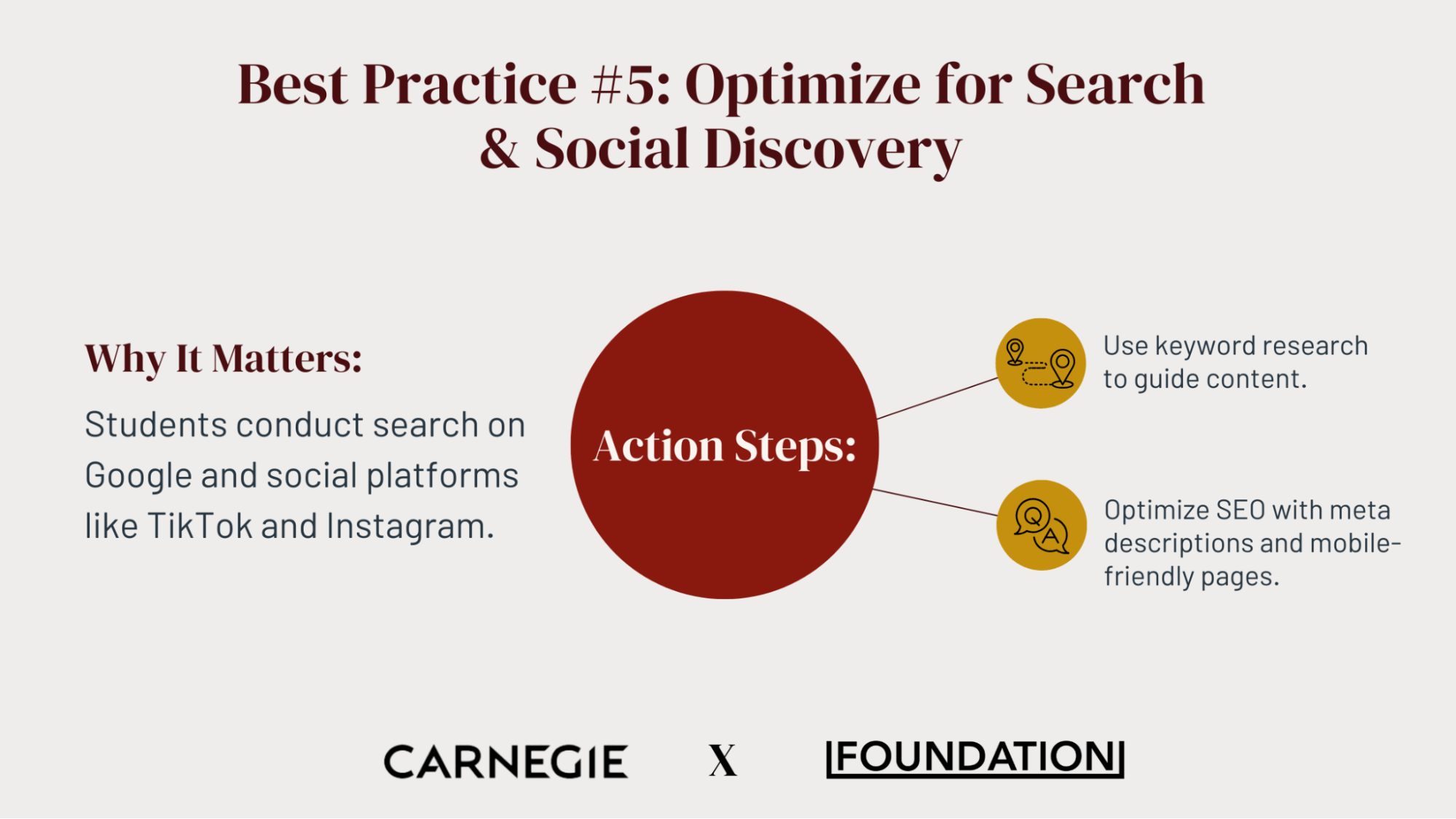
Why It Matters
For a prospective student (or parent) starting their college search, Google is the first stop. But social media platforms are now also doubling as search engines, with users typing queries directly into Instagram, TikTok, and YouTube.
If your institution’s pages don’t rank well, you’ll miss out on pivotal opportunities to connect with potential students.
Action Steps
- Conduct Keyword Research: Identify commonly searched queries related to college admissions, scholarships, campus life, majors, and career outcomes. Incorporate these keywords naturally into your blog posts, video titles, and social media captions.
- Incorporate On-Page SEO: Craft strong meta titles, meta descriptions, and headings. Ensure your website is mobile- and user-friendly so that visitors can easily navigate it.
Best Practice #6: Personalize Your Content Through Segmentation
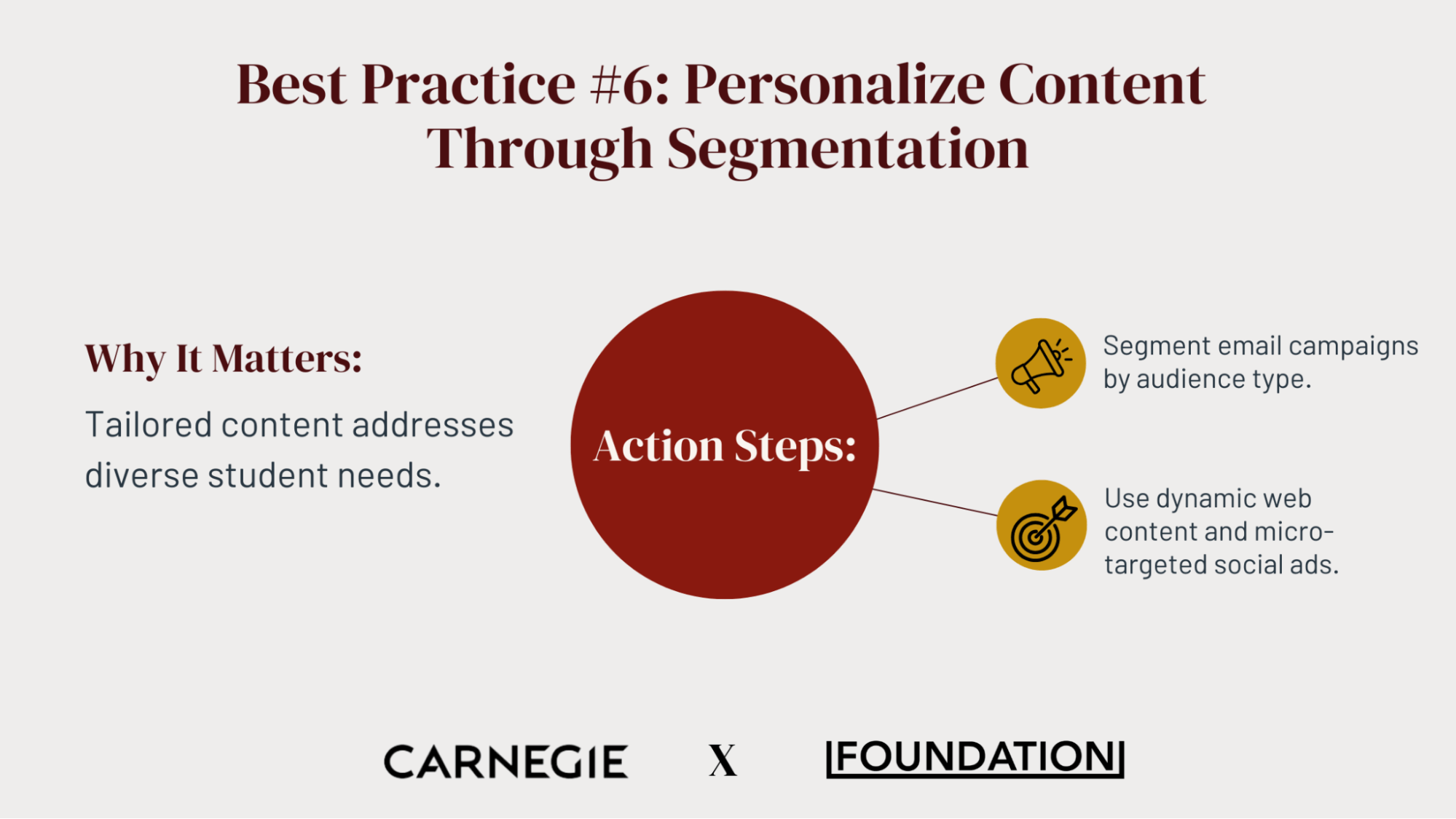
Why It Matters
Not all students have the same motivations or concerns. Undergraduate freshmen have very different needs than MBA candidates or returning adult learners. Personalizing your content for each segment will help you stand out as an institution that truly understands its audiences.
Action Steps
- Segment Your Email Campaigns: Separate your leads (undergraduates, graduates, international students, etc.) and tailor each email series accordingly.
- Include Dynamic Web Content: If possible, implement personalization tools that serve up relevant blog posts, program highlights, and campus event information based on each user’s browsing behavior.
- Micro-Target Social Ads: Run ads on Facebook, Instagram, or LinkedIn targeting specific demographics—like age range, interests, and job experience. For example, highlight scholarship opportunities for international students or flexible learning options for working professionals.
Best Practice #7: Activate Email Campaigns as a Nurturing Tool
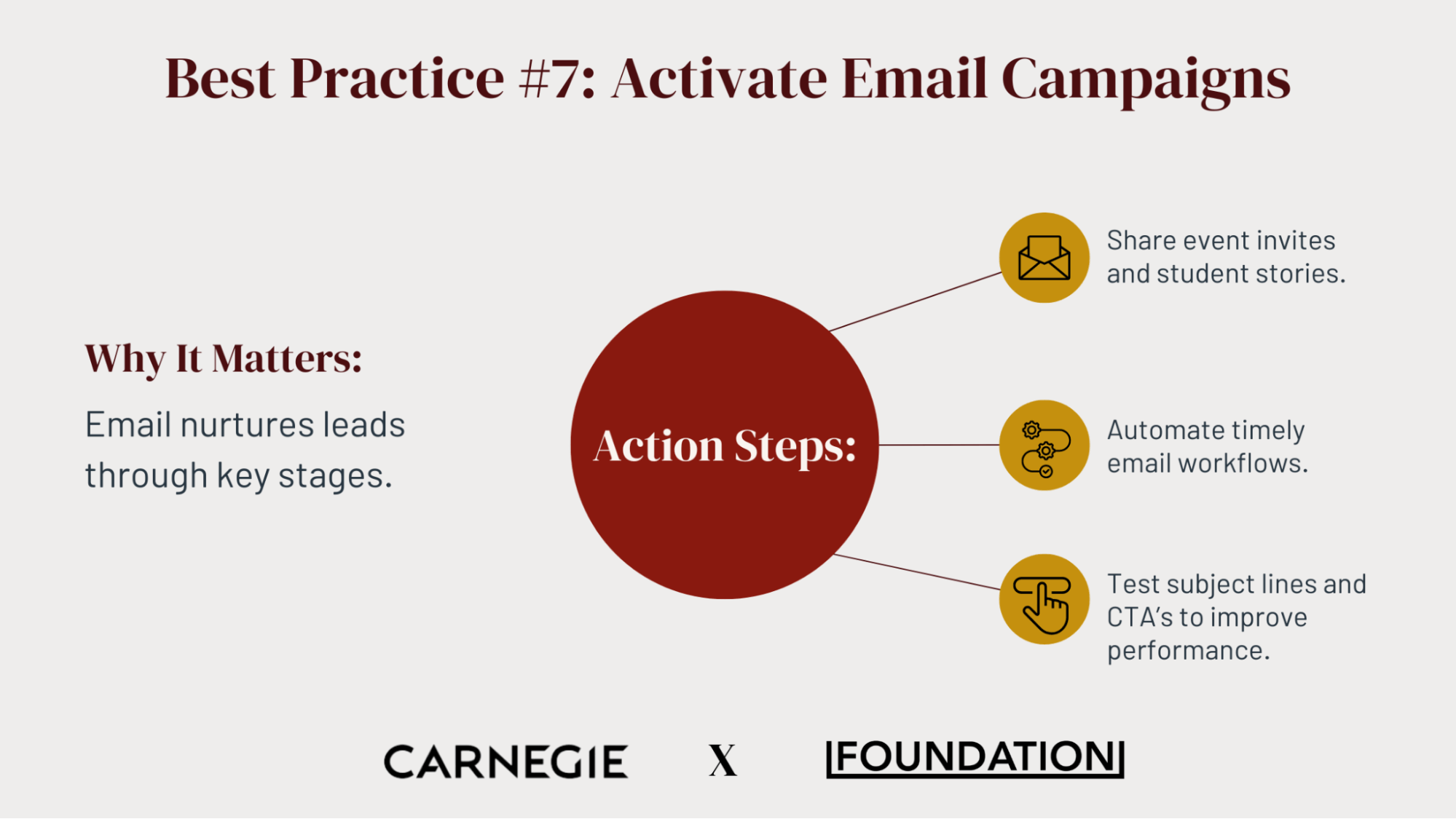
Why It Matters
While younger audiences may favor text messaging and social media, email remains a crucial channel for ongoing communication—especially as students move from casual exploration to deeper inquiry about your institution.
Action Steps
- Focus on Engagement: Instead of solely pushing application deadlines, share event invites, highlight student stories, or link to new blog posts. Show genuine interest in your audience’s journey.
- Automate Workflows: Create email drip campaigns that send out timely, relevant content to students, such as reminders for campus tours or key financial aid deadlines.
- Test and Refine: Track open rates, click-through rates, and conversions. If certain subject lines or calls-to-action aren’t resonating, adjust accordingly.
Best Practice #8: Prioritize Data Analysis to Refine Strategies
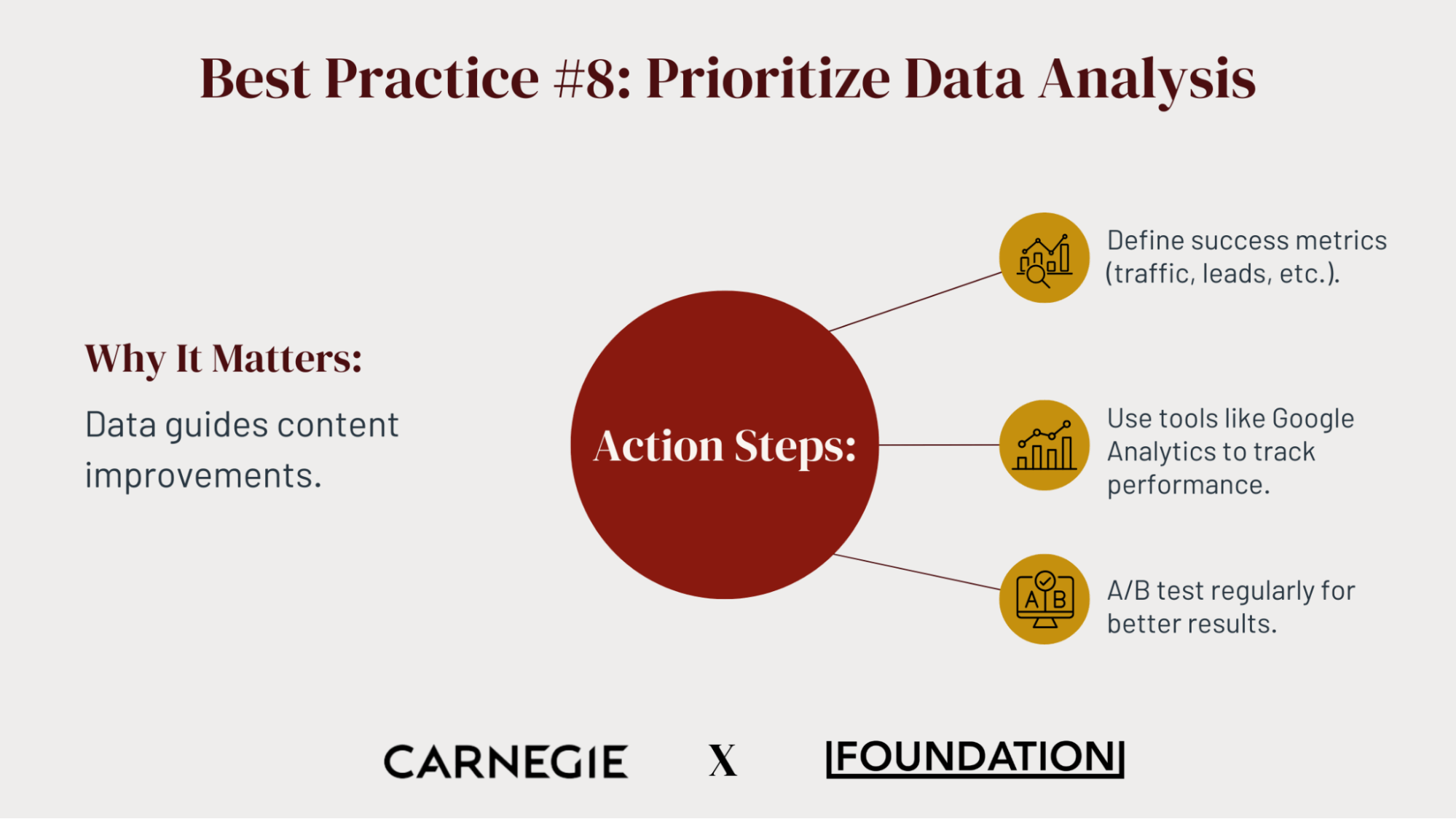
Why It Matters
Content marketing thrives on iteration. By monitoring key metrics—like website traffic, conversions, social media engagement, and email open rates—you can identify areas of success and pinpoint weak spots to pivot your approach.
Action Steps
- Define Success Metrics: Clarify which metrics matter most to your institution (social shares, completed application forms, event sign-ups, etc.).
- Use Analytics Tools: Google Analytics, social platform insights, and marketing automation dashboards can reveal user behaviors and content performance trends.
- A/B Test Regularly: From email subject lines to homepage banner images, A/B testing small variables can yield big improvements in engagement over time.
Best Practice #9: Explore Emerging Technologies and Trends
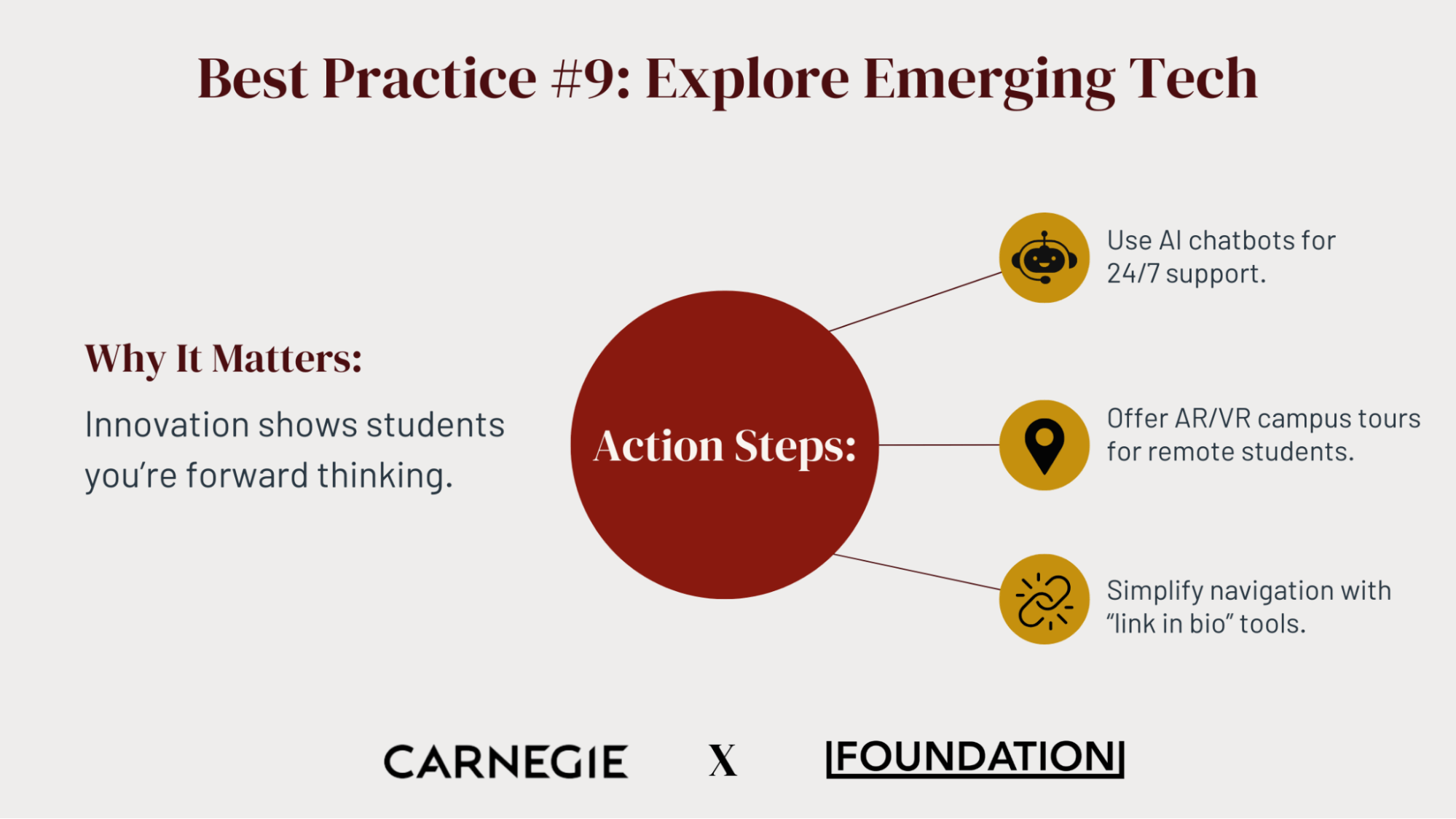
Why It Matters
Keeping an eye on new technologies or social trends can give your institution a competitive edge. Students value schools that embrace innovation and meet them on the platforms they frequent.
Action Steps
- Deploy AI-Driven Chatbots: Provide immediate answers to prospective students’ questions about admissions, housing, or programs. This 24/7 support can boost both engagement and satisfaction.
- Incorporate Augmented and Virtual Reality (AR/VR): Offer virtual campus tours or lab demonstrations, especially for international or remote students who can’t visit campus in person.
- Use Social Commerce and “Link in Bio” Tools: Make it easier for prospective students to navigate from your social media profiles directly to program pages, enrollment forms, or scholarship information.
Best Practice #10: Foster Community Through User-Generated Content (UGC)
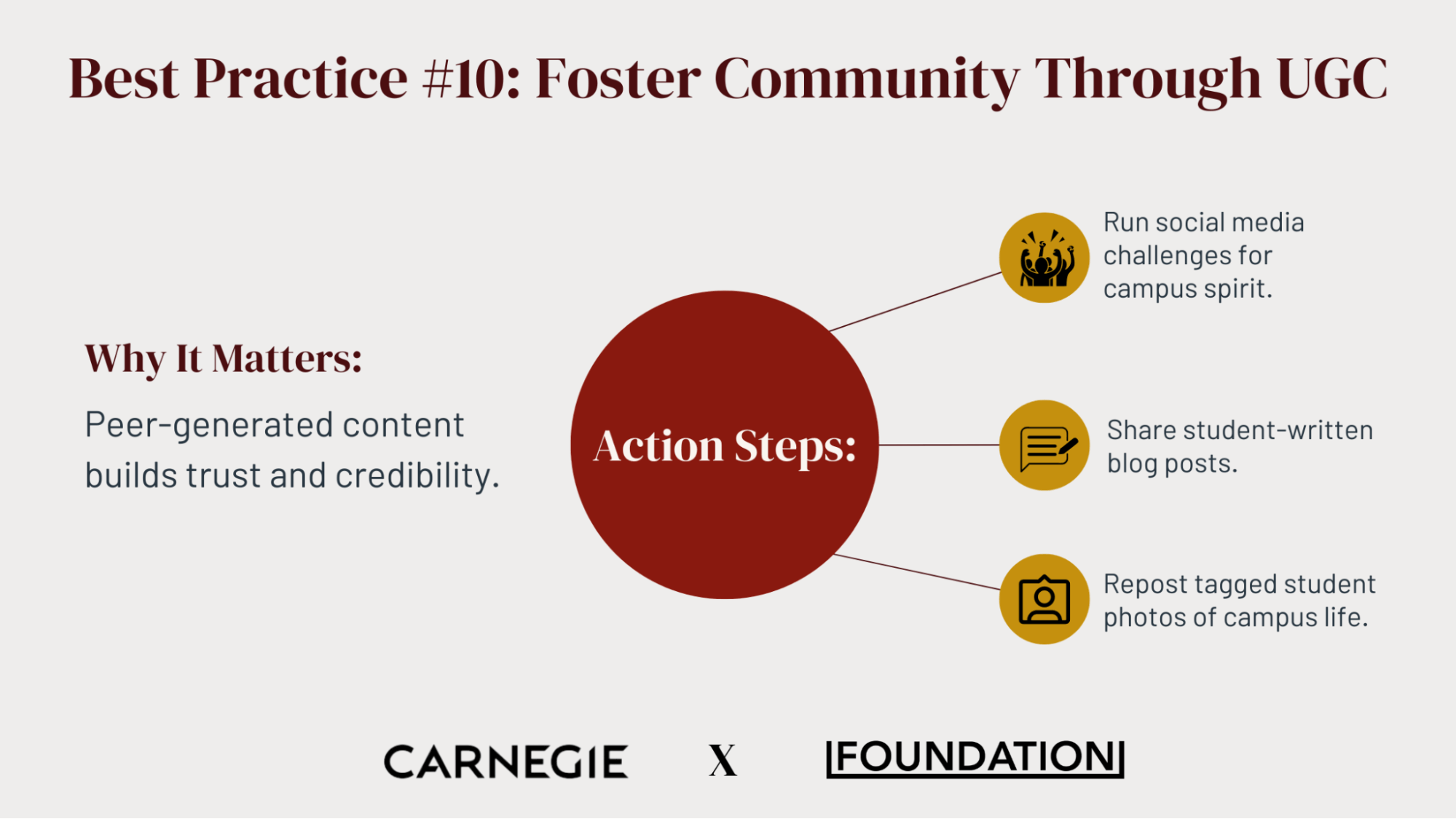
Why It Matters
Students often trust the word of their peers over official marketing materials. Encouraging your current students to share their own experiences provides authentic validation and boosts your brand’s credibility.
Action Steps
Create Social Media Challenges: Launch a campus spirit contest on TikTok or Instagram, encouraging students to show off their dorm decor, campus hack, or day-in-the-life videos. Reward the most creative entries with campus bookstore vouchers or other prizes.
Post Peer-Reviewed Blog Posts: Invite current students or alumni to write about their personal experiences with internships, study abroad, or research. Share these testimonials on your website and social media.
Feature Student-Generated Photos: Encourage students to tag your official accounts in their campus or event photos. Repost (with permission) to spotlight different perspectives of campus life.
WANT TO LEARN ABOUT OUR CONTENT MARKETING OFFERING? GET IN TOUCH.
Building a Future-Ready Content Strategy
In 2025 and beyond, the higher education landscape will continue to evolve, propelled by digital transformation and changing student expectations.
By implementing a well-rounded, data-driven content marketing strategy, you can create a powerful narrative that resonates with prospective students and drives meaningful engagement.
This strategy should balance storytelling with SEO best practices, short-form videos with in-depth blog posts, and personalization with authenticity.
Your institution’s story is unique.
Let your content marketing be the platform that broadcasts that story to the students, parents, and stakeholders who need to hear it most. By continually refining your strategies and staying current with emerging trends, you’ll set your institution apart and nurture lasting relationships for years to come.
Need help building a content marketing strategy tailored to your institution’s goals? Reach out to our team of higher education marketing experts.
We’ll help you craft an engaging content roadmap that brings your campus experience to life—and elevates your institution above the rest.
